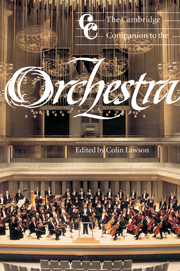Book contents
- Frontmatter
- 1 The history of the orchestra
- 2 The development of musical instruments: national trends and musical implications
- 3 The orchestral repertory
- 4 From notation to sound
- 5 The art of orchestration
- 6 The history of direction and conducting
- 7 International case studies
- 8 The revival of historical instruments
- 9 Recording the orchestra
- 10 Training the orchestral musician
- 11 The life of an orchestral musician
- 12 Historical recordings of orchestras
- 13 The orchestral composer
- 14 Educational programmes
- 15 The future of the orchestra
- Notes
- Appendices
8 - The revival of historical instruments
Published online by Cambridge University Press: 28 September 2011
- Frontmatter
- 1 The history of the orchestra
- 2 The development of musical instruments: national trends and musical implications
- 3 The orchestral repertory
- 4 From notation to sound
- 5 The art of orchestration
- 6 The history of direction and conducting
- 7 International case studies
- 8 The revival of historical instruments
- 9 Recording the orchestra
- 10 Training the orchestral musician
- 11 The life of an orchestral musician
- 12 Historical recordings of orchestras
- 13 The orchestral composer
- 14 Educational programmes
- 15 The future of the orchestra
- Notes
- Appendices
Summary
Introduction
During the past thirty years or so, historical performance in theory and practice has truly established itself as a vibrant part of the orchestral scene. Period instruments are routinely encountered in the concert hall from San Francisco to Budapest and from Toronto to Rio de Janeiro; indeed, they have become virtually obligatory in substantial areas of the orchestral repertory. There is now a widespread interest in recreating the original sounds and styles of a composer's own time and in acquiring appropriate instruments and technique. Meanwhile, the entire focus of such endeavours has been subject to stimulating discussion and argument. It cannot be denied that artistic life today makes demands which are decidedly unhistorical; for example, the microphone introduces a set of parameters which would have been unthinkable in previous generations. Furthermore, air travel has wrought such changes that we do not have the option to turn back the clock. Nevertheless, examination of a variety of primary sources, complementing tradition and intuition, enables earlier styles of performance to be explored; for, as Roger Norrington has remarked, ‘a relationship with the past needs to be founded on truth as well as sympathy, concern as well as exploitation, information as well as guesswork’.
Historical awareness in performance has a long and fascinating pedigree, which has been traced in some detail by Harry Haskell and others. In the late nineteenth century there finally sprang a growing desire to investigate instruments and performing styles that were contemporary with and appropriate to earlier music. At this time of great technological development, there was lively discussion as to whether orchestral instruments had been improving or had merely changed. For example, Wagner was in no doubt that in Beethoven’s symphonies valved trumpets and horns should be used rather than their natural precursors; he rewrote their parts to remove any supposed limitations.
- Type
- Chapter
- Information
- The Cambridge Companion to the Orchestra , pp. 155 - 168Publisher: Cambridge University PressPrint publication year: 2003



